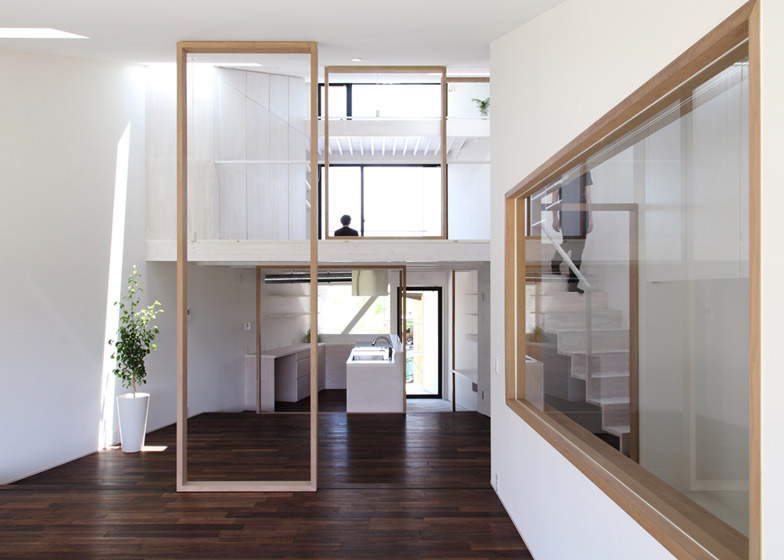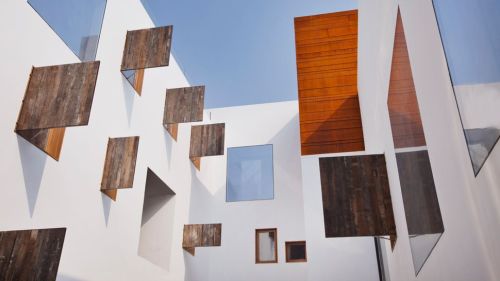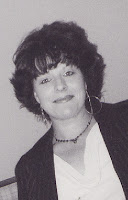I met Sam Spiczka last summer at Duluth’s Park Point Art Fair. Many of the usual artists were there, painters and photographers and ceramicists… and then there was this captivating collection of radically cool sculptures that reminded me of the museum of natural history that I went to as a kid. As it turns out, this is exactly where his inspiration comes from, inspired collectively by natural bone forms, rural technology, and geometric structures. When you finish reading this interview be sure to visit his website and see the range and scale of his imaginative designs.
EN: Your work is distinctive. What are the materials you work with and how did you learn these skills?
Sam Spiczka: I work mainly with Cor-ten, weathering steel. It's an industrial material most often used on outdoor structures where low maintenance is ideal. Cor-ten steel rusts to a certain point and then stops, creating a protective layer without needing any paints or protective coating.
I grew up working with steel from a very young age. My family's welding shop was (and still is) about 50 feet from the house, so the techniques of metal fabrication became second nature. One of my earliest memories is learning to sweep the shop when I was 5 or 6. I first learned to use a torch around 9 and I was welding at 11 or 12.
EN: Your inspiration comes from nature. Can you elaborate on that?
SS: When you grow up in the country with the closest neighbor about a half mile away, you spend most of your time wandering around outside by yourself. At least I did. I collected all manner of bones, interesting seed pods and neat pieces of wood. I always found them fascinating, much more vibrant and captivating than most anything created by humans. Their forms took root in my own imagination, and have inspired me since.
EN: You could have "painted" these unusual forms, but instead chose to sculpt them. Were there certain sculptors who have ignited your imagination to turn your ideas into 3-D expressions?
SS: I began drawing as a small child, but quickly turned to making things as I got older and learned to use tools. I like the solidity and complexity of physical objects. They assert themselves in the world. There are of course other past sculptors whose work I admire, but I've never felt that my work was directly inspired by any of them. More often I'm inspired by the biography of past sculptors, by their actions and lives. Knowing that they even existed was in itself a revelation at times. Rodin was probably the first revelation to me, and I still love his work. Of course Michelangelo as well. And Henry Moore, whose work is probably formally most similar to my own.
EN: How do you decide what size you will make these pieces?
SS: First you have to decide what the context for the finished work is. Scale is almost entirely a matter of context and distance. Will it be going indoors, outdoors, in a large park, in an intimate garden? But after many years, I find myself coming back to the scale of an upright human adult and how they interact with a work. The detailed texture of my sculpture lends itself to close examination so, I want the scale to be approachable as well. For outdoor work, I tend to like something 8-10' tall. That's big enough to hold it's own in the landscape but still approachable.
EN: Your current show got some press in Art in America magazine. Where did the title of the show "Midwest Gothic" come from?
SS: Grant Wood, of course, painted the iconic American Gothic. I had in mind not so much the exact imagery of that work, but his larger goal in life to establish a mid-western aesthetic. He thought great art could emerge from the landscape he actually lived in, not necessarily coming out of a European or East-coast American tradition. I agree with that, and see that as a goal of mine as well. My work is rooted in the landscape in which I live, which I find to have more permanence and substance than an art of fashion or trends, which generally dominates what we think of as the "Art World."
EN: Where do you currently live and how have the places you've lived influenced your work?
SS: I live in rural Sauk Rapids, MN - a bit Northeast of St. Cloud and a little over 6 miles from where I grew up. My studio is at the house, so I leave the property as seldom as possible. We bought some land out here a couple years back and when I'm not making sculpture, I'm working on planting a food forest/sculpture park hybrid I'm calling PermaSculpture. My sculptures have always felt as if they could have grown up out of this landscape... now I am actually growing this out of the land as well.
EN: Will you back at Park Point Art Fair next summer? Where else can we see more of your work?
SS: I will probably be back next year, but the best place to see my work is at www.sculptorsam.com
EdNote: Be sure to follow the link to his website. His output and imagination are both impressive. And if you get the chance, don't forget to see Diggity Dog Days this weekend at Duluth's Play Ground.
EN: Your work is distinctive. What are the materials you work with and how did you learn these skills?
 |
| Daedalus |
I grew up working with steel from a very young age. My family's welding shop was (and still is) about 50 feet from the house, so the techniques of metal fabrication became second nature. One of my earliest memories is learning to sweep the shop when I was 5 or 6. I first learned to use a torch around 9 and I was welding at 11 or 12.
EN: Your inspiration comes from nature. Can you elaborate on that?
 |
| Nexus |
EN: You could have "painted" these unusual forms, but instead chose to sculpt them. Were there certain sculptors who have ignited your imagination to turn your ideas into 3-D expressions?
 |
| Daphne |
EN: How do you decide what size you will make these pieces?
SS: First you have to decide what the context for the finished work is. Scale is almost entirely a matter of context and distance. Will it be going indoors, outdoors, in a large park, in an intimate garden? But after many years, I find myself coming back to the scale of an upright human adult and how they interact with a work. The detailed texture of my sculpture lends itself to close examination so, I want the scale to be approachable as well. For outdoor work, I tend to like something 8-10' tall. That's big enough to hold it's own in the landscape but still approachable.
EN: Your current show got some press in Art in America magazine. Where did the title of the show "Midwest Gothic" come from?
 |
| Kubrick |
EN: Where do you currently live and how have the places you've lived influenced your work?
SS: I live in rural Sauk Rapids, MN - a bit Northeast of St. Cloud and a little over 6 miles from where I grew up. My studio is at the house, so I leave the property as seldom as possible. We bought some land out here a couple years back and when I'm not making sculpture, I'm working on planting a food forest/sculpture park hybrid I'm calling PermaSculpture. My sculptures have always felt as if they could have grown up out of this landscape... now I am actually growing this out of the land as well.
EN: Will you back at Park Point Art Fair next summer? Where else can we see more of your work?
SS: I will probably be back next year, but the best place to see my work is at www.sculptorsam.com
EdNote: Be sure to follow the link to his website. His output and imagination are both impressive. And if you get the chance, don't forget to see Diggity Dog Days this weekend at Duluth's Play Ground.



























.jpg)















